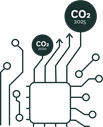Navigating Digital Climate Impact in Circular Economy Technology Businesses
Our Growing Digital Carbon Footprint
Digital technologies are responsible for around 4% of greenhouse gas emissions, and this figure is set to double between 2020 and 2025. Notably, communications tech is projected to emit more carbon by 2025 than any country except China, India, and the U.S.
With this realisation, businesses that develop digital platforms are coming to grips with the necessity of factoring digital climate impact into their overall climate goals.
As we explore the impact of digital technologies on carbon emissions, a 🎁 special opportunity awaits within this article.
The Quest for Circular Economy and Digital Responsibility
The just transition to a regenerative circular economy isn't merely a business imperative but a comprehensive strategy aligning environmental, social, and business goals. As disruptors of the linear economy, digital technologies have an opportunity—indeed, a responsibility—to set the standard for minimising environmental impact.
Complexity and Innovation: Double-edged Swords
Modern digital platforms are inherently complex. They encompass intricate cloud environments, diversified cloud databases, virtualisation technologies, serverless architectures, APIs, CDNs and much more. Adding to this complexity are the challenges of continuous innovation, particularly for digital enablers for circular economy projects that are often still in their nascent stages. Thus, balancing resource constraints and sustainability objectives is a considerable challenge.
Charting a Path for Reduction
Even as we navigate these complexities, the urgency for action remains. As technologists committed to catalysing circularity, the onus is on us to take actionable steps to minimise digital climate impacts.
The first step is measurement. It's crucial to understand the scope of digital emissions, which can be complicated by the myriad technologies and platforms involved. However, it's essential not to get stuck in 'analysis paralysis - the tendency to search for better measurements or more time and thus postpone action.
It’s proxies all the way down
We can’t directly measure the CO2e emissions from software. Therefore, the practical method for gauging your software's carbon footprint involves identifying the right proxies. Energy consumption, for example, is the main proxy for carbon emissions.
To calculate detailed breakdowns for software carbon emissions, you need access to detailed data regarding the energy consumption, carbon intensity, and hardware that your software is running on. This is challenging data to gather, to say the least!
Yet, we can start with simpler energy estimates based on other proxies, such as cloud costs and bandwidth usage, which are often indicative of energy and resource consumption.
Over time you improve the understanding of how & what to measure - and start to tick off the quick wins for reduction. It then becomes possible to more directly report on progress and set goals as part of your wider business climate goals.
Measuring progress
Using the Software Carbon Intensity (SCI) specification is then an excellent metric to encourage action.
If you make your application more energy efficient, hardware efficient, or carbon aware, your SCI score will decrease.
“The Software Carbon Intensity (SCI) specification is a methodology developed by the Standards Working Group in the Green Software Foundation, designed to score a software application along a dimension of sustainability and to encourage action towards eliminating emissions.
… an additional metric that helps software teams understand how their software behaves in terms of carbon emissions so they can make more informed decisions. “
It's the actions that matter
So what does action look like?
The Green Software Foundation outlines three fundamental principles:
- Energy Efficiency: Consume minimal electricity.
- Hardware Efficiency: Minimise embodied carbon.
- Carbon Awareness: Make effective use of clean energy.
Starting with Consumption Reduction
One of the core tenets of the circular economy is to consume less. This principle is equally vital in the digital realm. Before diving into operational efficiencies and technical jargon, ask a simple question: "Do we need this?" Whether it's data, files, redundant functionality, or additional servers, the first step towards green software is often a step back.
It's essential to establish metrics around CPU usage, storage needs, and network bandwidth to identify the culprits of excess consumption.
Bandwidth: Easy First Steps
Another important place to start is to reduce the data we are storing and transmitting. Compression algorithms (applied judiciously) can significantly reduce the size of data and files, leading to quicker data transfer and lower energy use. Likewise, code minification removes unnecessary characters from your source code without altering its functionality.
One major benefit of many cloud providers is the ability to host in regions closest to your users. Combined with Content Delivery Networks (CDN’s) and other techniques on the edge, allows you to do less beaming of information around the globe!
All are quick wins that can deliver immediate reductions in energy usage. You can then further build on this with architecture considerations such as reducing round trips and functionality/UX reviews.
Do less work
Yet another type of action that aligns nicely with the “reduce” concept in circularity, is to make your applications lazy! Intelligent caching and using cloud native functionality for features such as security means your application is doing less work. That, in turn, saves compute resources and uses less energy.
Of course, this can be achieved through careful architectural decisions that maximise physical device utilisation, examples include virtualisation and serverless computing.
Hosting: It really matters
Another area that offers an opportunity for quick impact is your choice of hosting provider. While it might be tempting to choose based on cost alone, it's essential to consider a provider's commitment to renewable energy and their overall climate targets. Even once you have chosen a provider, don’t be shy in asking them to be even better - it is customer advocacy which enables businesses to drive even more change.
Carbon-Aware Software: Sync with Renewables
Taking it a step further, carbon-aware software design focuses on conducting energy-intensive tasks during times when renewable energy sources are at their peak. This can be algorithmically determined based on the energy mix of the grid, enabling businesses to harness the most eco-friendly energy without manual intervention. While this might seem like a nuanced strategy, its impact can be profound, particularly at scale.
The Added Business Value
Aside from the ethical and environmental imperatives, focusing on carbon reduction often yields tangible business benefits. Improved software performance, for instance, can dramatically enhance user experience. The reduced data transfer needs and increased server efficiency can translate into lowered operational costs, providing both an economic and a moral incentive to adopt green software practices.
Further Learning and Resources
For those who wish to delve deeper, the Green Software Foundation's "Green Software for Practitioners" course offers comprehensive insights, especially their "Software Carbon Intensity (SCI) Specification".
In summary, the need for sustainable digital solutions in the circular economy is immediate and pressing. We are all still learning, but the time for action is now.
You may also be interested in our "Digital Footprint Optimisation Package," for which we're currently offering a limited number of free trials.



